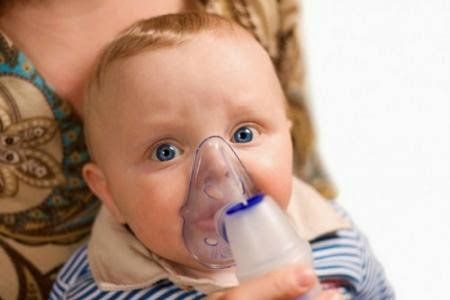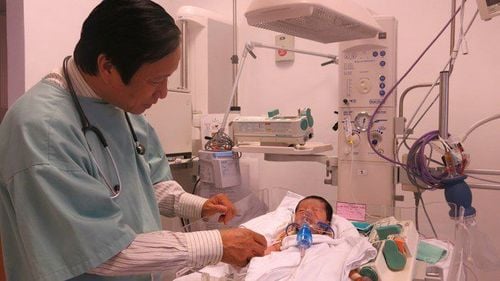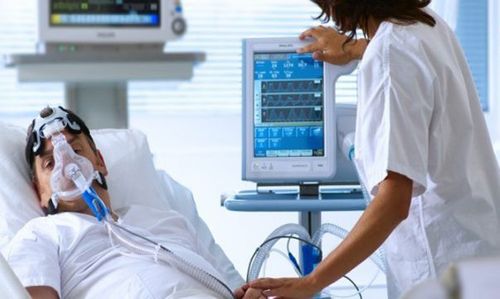This is an automatically translated article.
The article is expertly consulted by Master, Doctor Nguyen Tung Hoanh - Interventional Cardiologist - Department of Resuscitation - Emergency - Vinmec Nha Trang International General Hospital.Mechanical ventilation is an adjunct or alternative to respiratory function in critically ill patients. In order for mechanical ventilation to be highly effective, artificial ventilation is most physiologically appropriate, the PaCO2 parameter in arterial blood gas needs to be closely monitored and adjusted within the appropriate range through adjustments on the ventilator. .
1. What is PaCO2?
CO2 is the chemical symbol for carbon dioxide, which is the waste product of the energy-generating metabolism of all cells in the body. This component causes acidosis of the intracellular environment, so it is actively pumped out of any cell and discharged into the venous blood. They will be further excreted as HCO3- through the kidneys in the urine or as CO2 in the exhaled air volume in the lungs. In particular, the lungs play the main role of CO2 removal.Because of the above physiological mechanism, the concentration of CO2 in the exhaled air is also evaluated as a standard to help assess the effectiveness of artificial respiration intervention. However, unlike oxygen, the concentration of CO2 in the exhaled air occupies a very small volume, many times smaller than the excess O2 concentration. This makes measuring CO2 more difficult and less common.
Instead, clinicians will evaluate the effectiveness of the respiratory tool in mechanically ventilated patients through arterial blood gas with a parameter of PaCO2. This is the partial pressure of CO2 in the arterial blood, easy to measure and easy to use to calculate and adjust the ventilator.
2. Targets to adjust PaCO2 in mechanically ventilated patients
The pH of arterial blood is maintained stably in the neutral range of 7.4 - which is from 7.35 to 7.45. Any disturbance of respiratory function and should not or exceed the compensatory capacity of other buffer systems such as kidneys, erythrocytes, intracellular environment, blood pH will fluctuate and cause disturbances. other turmoil.In which, the normal PaCO2 parameter is considered to be in the range of 35 to 45 mmHg. If abnormalities in the respiratory system cause the PaCO2 parameter to exceed this range, the patient will be diagnosed as a respiratory acidosis (above 45 mmHg) or a respiratory alkalosis (below 35 mmHg). Accordingly, artificial ventilation in mechanically ventilated patients with acute respiratory failure is aimed at maintaining this normal range of the PaCO2 parameter.
However, if the patient is ventilated when there are underlying conditions that predispose to chronic CO2 retention, it is possible to maintain a somewhat higher PaCO2 than normal as in bronchial asthma and chronic obstructive pulmonary disease. At the same time, in acute lung injury (ARDS), the patient's PaCO2 can also be accepted as high because the adjustment focus is on oxygen concentration rather than CO2. In contrast, for patients with increased intracranial pressure, the indication for mechanical ventilation is to actively control the ventilation problem instead of affecting the respiratory function; PaCO2 now needs to be kept at a lower than normal level of 30-35 mmHg. Similarly, in patients with diaphragmatic hernia or pulmonary hypertension, ventilators are also set up to increase ventilation, reduce PaCO2 and thereby reduce pulmonary capillary pressure, improve symptoms for patients. However, PaCO2 should not be adjusted too low because it will inhibit the respiratory center.
3. How to adjust to reduce PaCO2 according to cause in mechanically ventilated patients
3.1 Low respiratory rate In fully controlled ventilation modes, the patient does not have a spontaneous breathing rate, the respiratory rate is a parameter that is actively set on the machine. When the breathing rate is slow, ie the ventilator has a low respiratory rate setting, artificial ventilation takes place disproportionate to the body's physiological needs. As a result, an amount of CO2 in the lungs is not released and remains in the blood, increasing PaCO2. This can be overcome in a very simple way by increasing the breathing rate on the ventilator. However, pay attention to monitor PaCO2 in the blood after adjustment, because too low PaCO2 is also detrimental.Conversely, if the ventilatory regimen is partially controlled, an increase in PaCO2 is evidence of ineffective patient stimulation. Specifically, the patient's ability to create a pressure change in the airway to stimulate the ventilator to create a supportive breath is still too weak, making the machine unrecognizable. The adjustment in this case is the need to set the ventilator to lower stimulus perception. Conversely, if the clinical judgment finds that the patient's ability to induce arousal is sufficiently effective, the cause will be the setting of the detector at too high a level. In addition, abnormalities in stimulus recognition may also be present. may be located in the ventilator harness, warming and humidification unit, membrane filter, endotracheal tube, or stimulus sensor. Therefore, before adjusting the sensing parameters on the ventilator, the doctor needs to re-check these parts, evaluate the compatibility, leak and correct if any.
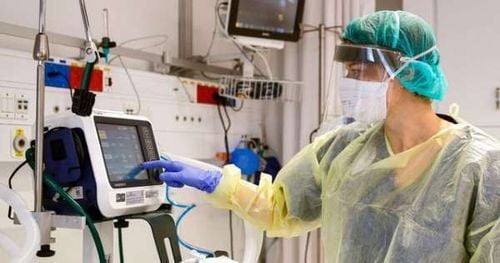
Trước khi điều chỉnh thông số nhận cảm trên máy thở, bác sĩ cần kiểm tra lại bộ dây máy thở, bộ phận làm ẩm và ấm, màng lọc, ống nội khí quản
Accordingly, the first thing to do is to increase the volume of air in volume-controlled ventilation or increase airway pressure in pressure-controlled ventilation. However, the increase of these parameters needs to be consistent with the patient's condition or condition. If the volume or pressure in the chest is increased too much, it can cause damage and trauma to the respiratory organs.
For the support machine mode, when the doctor notices that the tidal volume is low, the reason to think about is that the patient's ability to breathe on their own is still weak, because the respiratory system has not recovered. Thus, the doctor needs to increase the support of the machine. However, it is necessary to consider other reasons that can also reduce tidal volume such as air leakage in the airway, obstruction due to sputum sputum, compression, breathing tube folding...
3.3 Increase “dead space” The concept of “dead space” in mechanically ventilated patients is spaces that contain circulating air but do not contribute to gas exchange. These are useless volumes of air that are costly in the tidal volume of each breath but provide no respiratory benefit to the patient.
“Dead space” is unavoidable in diseases with structural damage to the lungs such as bronchiectasis, pulmonary embolism, etc. On the other hand, dead space can also be present due to the way the machine is set up such as: High PEEP usage, auto-PEEP (air traps) available. In addition, the wiring, tubing, membranes or devices placed on the airways with different uses from the ventilator to the patient's lungs also contribute to the mechanical "dead space".
Therefore, when noticing an increase in the PaCO2 in a patient's arterial blood gas, the clinician should check for unmanaged “dead spaces". If so, efforts should be made to minimize the amount of “dead space” to an acceptable level to improve the patient's respiratory efficiency.
3.4 Increased Respiration Coefficient Respiration (K) is defined as the number of CO2 molecules produced using 1 molecule of O2. In other words, the respiratory coefficient indicates the efficiency of the work of respiration; If the respiratory coefficient is lower, the respiratory work is more efficient and vice versa, if the respiratory coefficient is increased, the respiratory work becomes wasted, increasing CO2.
Respiration coefficient is also related to nutrition. For a normal person, when a balanced diet with three basic substances is protein, glucose and lipid, the respiratory coefficient is usually equivalent to 0.863. This means that when 1 molecule of O2 in the body is used and converted to energy-generating substances, 0.863 CO2 molecules will be released. On the contrary, if, for any reason, the patient is fed exclusively on carbohydrates through an infusion of Glucose 5.10%, the respiratory coefficient will increase to 1. The consequences of this will be discerned. through increased PaCO2 in arterial blood gases.
Thus, nutrition also plays an important role in the effective breathing in mechanically ventilated patients. These patients are often critically ill, require intensive care in the intensive care unit, and feed through a nasogastric tube. Accordingly, the diet needs to be balanced with substances through milk soups during the day in order to achieve the respiratory coefficient at a physiological level. Moreover, this also helps the respiratory muscles to ensure energy, which can take over again when weaning off the ventilator later.
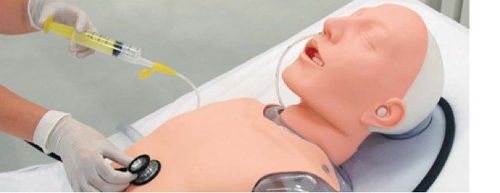
Bệnh nhân thở máy được nuôi ăn qua ống thông dạ dày
4. How to adjust the increase of PaCO2 according to the cause in mechanically ventilated patients
In contrast to the problem of ineffective respiration, which increases PaCO2 in arterial blood gases, too low a value in mechanically ventilated patients is also detrimental by inhibiting respiration. Therefore, the blood test needs to closely monitor important parameters to adjust the ventilator in the most appropriate mode.When noticing a decrease in PaCO2 in the blood, the causes may be an increase in respiratory rate or excessive hyperventilation, the doctor needs to adjust it down. In case the ventilator mode is supportive, the cause is due to the patient's good self-breathing ability and good airway stimulation, it is necessary to consider early weaning from the ventilator. However, the patient may also have stimuli that cause involuntary hyperventilation such as pain, fever, metabolic acidosis, fear..., finding the cause and correcting the patient is essential.
If the causes of the decrease in PaCO2 cannot be found, the appropriate intervention that can temporarily increase the PaCO2 is to actively create a "dead space" to keep CO2 with procedures such as lengthening the breathing tube, adding more connection... However, in any case, after adjusting to increase PaCO2, the doctor needs to re-evaluate with blood gas, to prevent excessive increase causing uncontrolled respiratory acidosis.
Mechanical ventilation is a proactive respiratory control intervention. In which, PaCO2 is one of the parameters that need to be monitored through arterial blood gas to adjust the ventilator in a timely manner. Only when this is warranted can the mechanically ventilated patient be assured of respiratory efficiency and possible recovery of the pathology.
Caring for ventilator patients is very important and directly affects the patient's health and recovery. Therefore, patients need to be cared for by a team of qualified, qualified, and professional doctors, nurses, and nurses.
Vinmec International General Hospital is a medical facility with highly qualified and professional human resources from famous domestic and international medical universities. The most modern and advanced equipment system in Vietnam. Here, patients are cared for wholeheartedly, thoughtfully, with quick recovery time.
Please dial HOTLINE for more information or register for an appointment HERE. Download MyVinmec app to make appointments faster and to manage your bookings easily.






